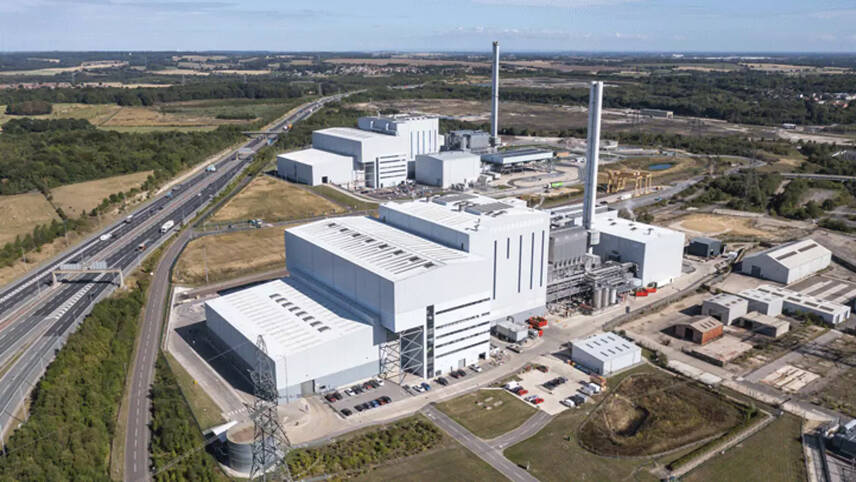This premium content is exclusive to edie Members.
To find out more about edie Membership, please click below.
If you are an existing member, login here

Pictured: The Ferrybridge EfW plant. Image: enfinium
At a glance
Who: enfinium and Navigator Terminals
What: Rail link to permanently store captured carbon
Where: Ferrybridge EfW plant in West Yorkshire
Why: Provide a safe transportation option for captured carbon
When: MoU signed March 2023
The challenge
The UK Government has earmarked £20bn into carbon capture solutions, but while all locations would benefit from capturing carbon, not all are suitable for permanently storing it. Solutions are required to help with the transportation of captured carbon.
The solution
Energy-from-waste (EfW) firm enfinium signed a Memorandum of Understanding with Navigator Terminals, which specialises in storing gas in liquid form to develop a rail corridor to transport captured carbon in the UK
How it works
The agreement concerns the development of a new rail corridor between enfinium’s Ferrybridge EfW plant in West Yorkshire and Navigator Terminals’ storage facilities in Teesside.
The corridor will be using the East Coast Main Line and then linking into the Stockton Spur. Freight will be scheduled around passenger services on the line and will be sent at quieter periods, such as night-time.
The project would provide safe options to transport CO2 captured at enfinium’s facilities, permanently storing the biogenic emissions captured from its waste stream. The CO2 would then be transported safely offshore from Navigator’s facilities for permanent storage. Bechtel, a global leader in engineering, construction, and project management, has been selected to support the feasibility work underpinning the concept.
Navigator operates four terminals in major UK ports and serving key demand centres within the UK. Across these locations the organisation can offer storage solutions for crude, petroleum, chemical, bitumen, liquefied gas and biofuel products.
Once the capture carbon arrivals at Navigator Terminals’ bulk liquid storage site, it can then be shipped off for permanent storage under the North Sea.
The results
enfinium estimates that some 700,000 tonnes of emissions could be captured from the Ferrybridge EfW plant each year once man-made carbon capture technologies are fitted there at scale. The project will decarbonise enfinium’s Ferrybridge EfW facility, delivering 3% of UK Government’s 2035 target for negative emissions.
It is hoped that the new rail freight link would benefit other companies looking to capture carbon and store it permanently within the UK, as well as enfinium.
Industry context
The Climate Change Committee (CCC) has recommended that the UK aims to host at least 22 million tonnes of annual CCS capacity online this decade, in order to support its legally binding 2050 net-zero target. This should be used not as an excuse not to reduce emissions, the CCC has stated, but as a means to align hard-to-abate sectors with the nation’s legally binding climate targets.
The Government has subsequently outlined a vision to invest an unprecedented £20bn in CCS over the next 20 years.
Net-Zero Teesside
Under the UK’s net-zero ambition, the Government has committed to fully decarbonising at least one industrial cluster by 2040. This has spurred a race between clusters in the North West, Teesside, Humberside, Grangemouth, South Wales and Southampton to become the first to do so.
Energy giants and businesses operating in Teesside and Humberside look set to collaborate on the deployment of carbon capture usage and storage (CCUS) technology in a bid to create net-zero industrial clusters.
The Humberside and Teesside projects are leveraging their knowledge through a new partnership that will develop net-zero carbon industrial clusters. These two regions account for nearly 50% of all UK industrial cluster emissions. Businesses in the regions are working collaboratively through the East Coast Cluster.
The NEP, Net Zero Teesside and Zero Carbon Humber believe that the East Coast Cluster can capture, transport and store up to 27 million tonnes of carbon emissions annually by 2030. The Cluster could also support an average of more than 25,000 jobs each year between 2023 and 2050.
© Faversham House Ltd 2024 edie news articles may be copied or forwarded for individual use only. No other reproduction or distribution is permitted without prior written consent.


